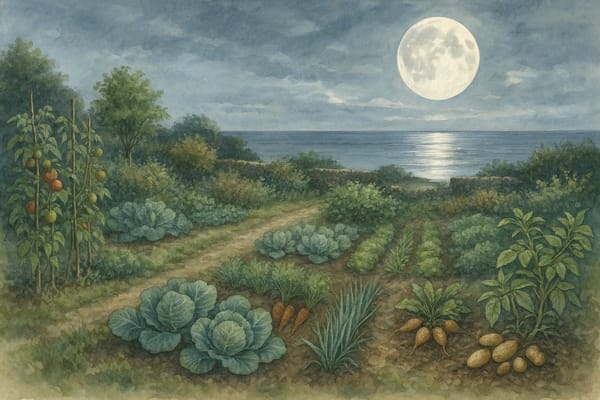Seasonal turning points as anchors for lunar gardening
The garden’s year is not only written in buds, blossom, and harvest, but also in the quiet hinge points when the light changes course — the solstices and equinoxes. In Cornwall, where the ocean tempers the seasons and the moon pulls the tides close to the shore, these moments hold both practical and symbolic value for gardeners who work with lunar rhythms. Aligning your planting, transplanting, and feeding with the moon phases that fall nearest to each solstice or equinox can help root your work in the season’s natural energy.
While moon-phase planting is rooted more in tradition and long observation than in strict science, many Cornish gardeners find it keeps them working rhythmically and attentively. This kind of seasonal awareness can improve garden record-keeping and encourage more intentional action, ensuring each sowing or transplant feels like part of a broader story.
Summer Solstice — Peak Light and Energy
Around 21 June
The longest day marks the height of growth. In lunar gardening lore, if a waxing moon or full moon coincides with this period, it’s considered a moment of maximum upward energy. Old sayings linger in Cornish villages, where it’s said that sowings made at midsummer will “rise with the light,” carrying the season’s long days into their stems and leaves.
Crops and Flowers
- Fruiting vegetables such as beans, squashes, and tomatoes
- Midsummer flowers like cosmos, calendula, zinnias, and cornflowers
- Fast greens for summer salads
Moon Phase Advice
- Waxing/Full Moon near solstice: Sow and transplant above-ground crops for lush growth and flower production.
- Feed annual beds with liquid seaweed or compost tea to sustain energy during peak growth.
Winter Solstice — The Return of Light
Around 21 December
The shortest day signals a subtle turning back toward growth. In Cornwall, mild winters often allow more to be done now than in colder inland regions.
Crops and Seeds
- Winter brassicas (cabbage, kale, purple sprouting broccoli)
- Hardy annuals and overwintering broad beans
- Garlic and shallots in well-drained beds
Moon Phase Advice
- Waxing Moon after solstice: Sow or transplant above-ground winter crops and protect them with fleece in exposed gardens.
- Waning Moon before solstice: Focus on pruning, clearing beds, and applying nutrient-rich mulches — seaweed is a Cornish favourite for this season.
Spring Equinox — Renewal and Fresh Starts
Around 20 March
Day and night are balanced, and the soil begins to warm. This is one of the most active planting periods of the year.
Crops and Seeds
- Early leafy greens, peas, spinach, and chard
- Early root crops like carrots and beetroot
- Seed-starting indoors for tomatoes, peppers, and tender annuals
Moon Phase Advice
- Waxing Moon after equinox: Sow leafy and fruiting crops for strong germination and above-ground growth.
- Waning Moon after full moon: Direct sow root crops, turn in green manures, and prepare beds for the next wave of planting.
Autumn Equinox — The Season of Storing
Around 23 September
With light and dark in balance once more, the focus turns toward crops that will feed the colder months and the renewal of the soil.
Crops and Seeds
- Overwintering onions, garlic, and spring cabbages
- Spinach and hardy salad leaves
- Flowering bulbs for spring
Moon Phase Advice
- Waxing Moon near equinox: Sow leafy autumn crops and start overwintering greens.
- Waning Moon after equinox: Plant bulbs, set garlic cloves, and prune or weed to prepare for winter rest.
Adjusting Tasks to Moon and Season
| Seasonal Anchor | Moon Phase | Best Gardening Tasks |
|---|
| Summer Solstice | Waxing/Full Moon | Sow/plant flowers, fruiting veg, feed annual beds |
| Winter Solstice | Waxing Moon | Sow/transplant winter brassicas, hardy annuals |
| Waning Moon | Mulch, prune, compost, bed preparation |
| Spring Equinox | Waxing Moon | Sow greens, peas, start seedlings indoors |
| Waning Moon | Direct sow roots, turn green manures |
| Autumn Equinox | Waxing Moon | Sow spinach, onions, hardy salads |
| Waning Moon | Plant bulbs, garlic, weed, prune |
Cornwall-Specific Tips
- Mild winters allow winter solstice plantings to establish without the deep freeze, but shelter young plants from wind.
- Seaweed mulch after autumn equinox and winter solstice feeds soil, insulates roots, and reflects a long-standing Cornish gardening tradition.
- Microclimates matter: in valley gardens, watch for humidity; on exposed coasts, protect transplants from salt-laden winds.
In Summary
Solstices and equinoxes give structure to the gardener’s year, and when paired with the moon’s phases, they become anchor points for thoughtful, timely action. Use waxing moons for sowing and transplanting leafy and fruiting crops, and waning moons for roots, bulbs, pruning, and soil work. In Cornwall, where the seasons turn gently but surely, this rhythm blends tradition with practical success — and, as local lore has it, midsummer sowings will indeed “rise with the light.”









